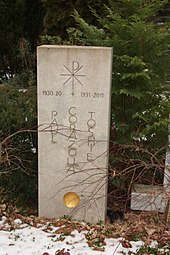Paul Corazolla
Paul Salvatore Corazolla (born June 21, 1930 in Berlin ; † October 16, 2018 there ) was a visual artist with a focus on glass painting . In many parts of Germany and beyond, he designed stained glass windows for churches and public buildings, developing a haunting, symbolic and sensual language of images and colors that transcends the objects through abstraction and often varies them in geometric motifs.
To person
Corazolla was born as the second child of the singer Margarete Corazolla (1902-2001). His father Paul Graener was a composer, his younger brother Jan Corazolla a conductor and cellist. In 1940 Paul Corazolla was accepted into the humanistic Arndt-Gymnasium in Berlin-Dahlem. In 1943, due to the war, he moved to Austria, where he received his first drawing lessons from the Viennese secessionist Carl Moll .
After the end of the war and the Abitur for gifted students, Corazolla began studying at the Berlin University of Fine Arts with professors Friedrich Stabenau and Ernst Fritsch and the Bauhaus teacher Debus. As part of further studies from 1951 for free and applied graphics, Paul Corazolla met expressionists such as Karl Hofer , the director of the university, Max Pechstein and Karl Schmidt-Rottluff .
After completing her studies, Corazolla worked as a freelance artist in the Friedenau studio, but was also active in the Berlin art business. From 1983 he headed the Tiergarten Art Office and the Upper Gallery in the house on Lützowplatz for twelve years. In almost 90 exhibitions he presented contemporary art with a few hundred artists of that time. Conception, design and the publication of catalogs rounded off the responsible work.
Until her death in 2011, Corazolla was married to Toshie Nanjo, who came from a northern Japanese samurai family. Both joined the German-Japanese Society in 1966 . Toshie's grave with a gravestone designed by Paul Corazolla and prepared for him is in the cemetery of the St. Matthias Congregation in Berlin. He was buried there on October 30, 2018.
Participation in committees
- Chairman of the Professional Association of Visual Artists Berlin ,
- Member of the jury for the Moses Mendelssohn Prize of the State of Berlin,
- Member of the Art Commission of the Diocese of Berlin,
- Advisory Board of the Karl Hofer Society ,
- Adviser to the German Bishops' Conference in matters of art.
Glass window (selection)
See also web links.
- Berlin, BEWAG headquarters (1959, currently stored due to relocation)
- Madrid, German School (1960)
- Warburg, St. Jakob von Sarug (formerly Assumption of Mary) (1967)
- Berlin-Wilmersdorf, Holy Cross Church (1976)
- Berlin, Evangelical Forest Hospital (1976)
- Hildesheim-Ochtersum, St. Alfred Church (1977)
- Berlin-Lichterfelde, Chapel "Mother of Good Advice" (today " Eben-Ezer-Chapel ") (1980)
- Paderborn, Poor Clare Monastery (1985)
- Berlin, St. Franziskus Hospital, vestibule (1980)
- Essen-Steele, Evang. Lutherhaus Hospital (1985)
- Essen-Frintrop, Catholic Church of St. Joseph (1986–1990)
- Windecken, Niederau, St. Marienkirche (1987)
- Mülheim an der Ruhr-Speldorf, Catholic Church of St. Michael (1988)
- Berlin, chapel in the Rudolf Virchow University Hospital (1997)
- Strausberg (Brandenburg), St. Marien (1997)
- Oberhausen-Sterkrade, St. Clemens-Hospitale (no year)
Publications
- Both Matthias-Grünewald-Verlag and Herder-Verlag have numerous articles, writings and publications by Paul Corazolla.
literature
- Archdiocese of Berlin (ed.): Paul Corazolla: glass windows, works on paper, texts. Regensburg 2000, ISBN 3-7954-1381-8 .
- Resurrections. Window cycle St. Josef, Frintrop. Paul Corazolla (drafts) and Herbert Fendrich (texts). Publishing house Peter Pomp, Essen 1991.
- Paul Corazolla: God's Showcase - Paths of Optical Mission. 2nd edition, Düsseldorf 1959.
Web links
- Stained glass window in St. Jakob
- Stained glass window in the Clarisse monastery
- Glass window in the Luther House
- Stained glass window in St. Joseph
- St. Michael stained glass window
- St. Joseph stained glass window (stained glass window 8 to 22)
- Works by and about Paul Corazolla in the catalog of the German National Library
- Basic data and images ( Memento from February 27, 2015 in the Internet Archive )
- Paul Corazolla 2014 in conversation with BF Müller
Individual evidence
- ↑ Cherry Blossom & Edelweiss. Importing the exotic. Retrieved July 24, 2017 .
- ↑ Kawaraban October 2001 , October 2001, accessed July 24, 2017 .
- ^ Paul Salvatore Corazolla. Der Tagesspiegel , October 28, 2018, accessed on October 29, 2018 .
| personal data | |
|---|---|
| SURNAME | Corazolla, Paul |
| ALTERNATIVE NAMES | Corazolla, Paul Salvatore (full name) |
| BRIEF DESCRIPTION | German artist |
| DATE OF BIRTH | June 21, 1930 |
| PLACE OF BIRTH | Berlin |
| DATE OF DEATH | October 16, 2018 |
| Place of death | Berlin |



